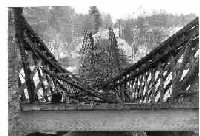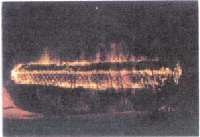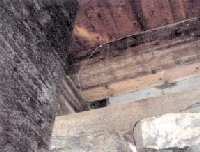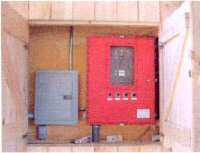FIRE PROTECTION AND FIRE PREVENTION ON
COVERED BRIDGES
PART 2
Robert H. Durfee, P.E.1
I. ABSTRACT
Prior to the advent of steel and concrete as primary materials for constructing bridges, timber
was the material of choice. Between 1810 and 1910, several thousand covered bridges were built
throughout the United States. Today only about 850 remain, many having been lost to flood,
hurricane, neglect, or fire. Of those that have been lost in recent years, the vast majority have been
destroyed by fire, either accidentally or by arson.
 |
Slate Covered
Bridge.
Swanzey, NH |
In 1992, three (3) covered bridges in New Hampshire were totally destroyed by arson. As a
result of these incidents, the "New Hampshire Covered Bridge Task Force," was created. This
task force consisted of federal, state, and local governmental agencies that had jurisdiction over
covered bridges in New Hampshire.
This paper, which is a continuation of the work prepared under the direction of the Covered
Bridge Task Force, presents findings relative to the causes and resulting damage to over thirty
(30) covered bridges and, based on these case studies, presents several methods that can be used
to reduce the potential threat of damage or loss by fire. Experience gained by designing and
installing fire protection and detection systems on seven (7) recent covered bridge replacement or
rehabilitation projects is also presented. Fire protection and detection systems discussed include:
fire retardant paint, heat detectors, sprinkler systems, alarms, lighting, and hydrants.
Measures that can be taken by covered bridge owners to protect these historic structures from
destruction due to fire are identified as follows: (1) deterrence; (2) reducing the fire potential; and
(3) arresting the fire. The importance of each of these measures in discussed in depth as well as
the advantages and disadvantages of each measure.
II. INTRODUCTION
There are three key measures that should be taken to protect covered bridges:
- Deterrence--measures taken to prevent a fire from starting;
- Reducing the fire potential--measures taken to make starting a fire difficult, or limit damage
by fire;
- Arresting the fire--measures taken to quickly extinguish a fire.
III. NATURE OF COVERED BRIDGE
FIRES
 |
Slate Covered
Bridge
Egulfed in Fire |
In the past ten years there have been approximately thirty-four (34) covered bridge fires in the
United States (see Table I). On average, there are one or two bridges lost to fire each year.
There is much in common with these recent covered bridge fires. All were started by
arsonists or were of suspicious origin, and started late at night. Few bridges had any systems to
detect a fire or prevent a fire from being started. Most were poorly lit and some had no lighting at
all. Some bridges were in remote locations and most were served by volunteer fire departments.
Most bridges had been burning for some unknown period of time prior to notification and the fires
had spread quickly and engulfed the entire structure. Almost all bridges were completely
destroyed. Only ten (10) bridges of the thirty-four (34) bridges studied survived in a condition to
be repaired.
It is clear that arson is the cause of every covered bridge fire in the last ten years, and the lack
of fire protection or detection methods on these bridges resulted in significant damage or total
destruction.
Table 1
Covered Bridge Fires
In The United States
1992 - 2002
|
Year
1992
1992
1993
1993
1993
1993
1993
1993
1993
1993
1994
1994
1994
1994
1994
1995
1996
1996
1997
1997
1997
2000
2001
2002
2002
2002
2002
2002
2002
2002
2002
2002
2002
2002
|
Bridge Name
Loy's Station
Parker
Slate Bridge
Jordan
Corbin
Smith
LeMay
Ferry
Nectar C.B.
Sells
Kilgore Mill
Wolf Bridge
Grimes
Guilford
Kaufman's Distillery
Upper Sheffield
Miller Road
Wimer
Carman
Offult Ford
Lower
Wilkinson
Henniger Farm
Pine Grove
Ryot Bridge
Orne Bridge
River Road
Cedar Bridge
Henderson
Risser's Mill
Jackson
Jeffries Ford
Woodsville
Newfield
Wilson's Mill
|
Location
Thurmond, MD
Wyandot, OH
Swanzy, NH
Slayton, OR
Newport, NH
Plymouth, NH
Jefferson County, MO
Nectar, AL
Lisbon, OH
Walton, GA
Knox County, IL
Ruff Creek,PA
Dearbourn County, IN
Sporting Hill, PA
Sheffield, MA
Columbiana County, OH
Jackson County, OR
Cherry Hill, PA
Rush County, IN
Irasburg, VT
Rock Falls,IA
Washington Township, PA
Lancaster County, PA
Clair Township, PA
Irasburg, VT
Troy, VT
Winterset, IA
Gladstone, IL
Mount Joy Township,
PA
Turkey Run Park, IN
Bridgeton, IN
Haverhill-Bath, NH
Tompkins County, NY
West Middleton, PA
|
Comments
Survived
Survived
Survived
Survived
Survived
Survived
Survived
Survived
Survived
Survived
|
IV. DETERRENCE
Deterrence is measures which can be taken to deter a would-be arsonist from attempting to
start a fire. For deterrence to be effective, the measures taken must increase the concern
on the part of the arsonist that they could be caught and prosecuted; or lower the arsonist's
expectations that a fire could be easily started or started at all. Several deterrence methods or
systems are available, as follows:
- FIRE DETECTION SYSTEMS -- Three types of fire detection systems are
considered, as follows:
- Smoke Detectors -- Experience has shown that smoke detectors can easily be set
off by pranksters or by smoke resulting from the friction of tires against a timber bridge deck or
from exhaust fumes from large trucks with upright exhaust stacks. Further, dust and dirt can
accumulate at the openings of the detectors and either cause false alarms or cause the detector to
become inoperable. If police and fire officials are repeatedly responding to false alarms,
deterrence will become ineffective. Therefore, smoke detectors are not recommended for covered
bridge applications.
- Flame Detectors-- Flame detectors are fire detection systems which have sensors
which react with the infrared active gasses produced by the combustion of wood. They are
suitable for open-air applications and have a second sensor which checks for typical interference
sources. The range of a typical sensor is 30 feet with a 100°: range. Multiple sensors must
be installed through the bridge which increases installation costs and sensors cannot be installed in
all locations to give complete coverage of a bridge.
- Heat Detectors -- Heat Detectors, which automatically detect excessive heat created
by a fire, can be installed underneath the bridge roof framing, preferably along the underside of the
ridge line of the roof.
 |
| Heat
detector |
Fire detection systems that utilize early warning linear heat detection technology are best
suited for covered bridges and can withstand the harsh environments in which they must exist.
This system utilizes a continuous loop of fixed temperature heat detection cable which responds
to overheat and fire in the early ignition stages before the combustion process can
generate smoke. The linear heat detection cable will detect an overheat condition or fire
anywhere along its entire length. The cable may be installed along the bridge in areas not
generally visible to the public, such as: roof area, under the roof peak, beneath the eaves, handrail
areas, under deck areas, floor beams and bearings. The cable is available in several colors to
blend in with the color of the bridge or timbers.
- ALARMS -- Audible alarms such as bells or horns, or visible strobe types alarms can
be mounted at one or two locations on the bridge to warn the general public in the area of a fire,
to deter a would-be-arsonist, or scare off a prankster intent on setting off fire detectors or
sprinkler systems. Alarms can easily be activated by heat detectors or sprinkler systems. The
effectiveness of audible alarms is severely diminished at remote sites.
 |
| Typical Light
Installation |
- LIGHTING -- A well lit bridge and approaches can deter vandalism and arson. The
entire length of the bridge and the entire length of any sidewalk should be illuminated. The
installation of vandal-proof fixtures with metal halide or mercury vapor lamps is recommended.
The approaches to a bridge should also be well illuminated by the use of conventional street
lights mounted on utility poles.
 |
Typical Control Panel
with
Telemetering |
- TELEMETERING -- Fire detection devices or sprinklers can be telemetered to
activate an alarm at the local police or fire station. Informing the fire department through
telemetering can substantially reduce the notice time and response time by the fire department
once a fire has begun.
- VIDEO CAMERA -- The installation of a video camera monitoring system can be a
deterrence (especially if signs are properly posted indicating its existence). In order for the
camera to be effective, proper lighting on the bridge and approaches must be provided, as well as
24-hour monitoring of the camera. Video cameras at remote sites will also need to be protected
against vandalism.
It should be noted that video surveillance using tape backup will probably not aid in
identifying suspects after a fire since a would be arsonist can easily disguise themselves and avoid
recognition by the camera.
V. REDUCING FIRE HAZARD
If deterrence fails and an arsonist is able to start a fire, there are several measures that can be
taken to make it difficult for a fire to get started, or once a fire has started, to prevent its spread
an limit the damage to a small area. Several methods of reducing fire hazard are presented as
follows:
- RETARDANT TREATED WOOD -- When building a new covered bridge or
replacing timber members on an existing covered bridge, the timber used can be pressure treated
with a fire retardant chemical which either prevents the wood from igniting by increasing the
flame point or preventing the spread of the fire once a member has ignited. Retardant treated
wood is most effective when used for siding, roof decking, and roof shingles. These thin elements
are typically the easiest to ignite and tend to be the fuel for a covered bridge fire that can
eventually destroy the main structural members of the bridge (i.e., truss members, floor beams,
decking, and cross bracing).
Fire retardant timber can also be used for main structural members such as trusses, decking
and floor beams, either for new construction or for replacement of deteriorated or broken
members. It should be noted that when pressure treated fire retardant timber is used as a
structural member, the member's strength is reduced by approximately 10 to 20%.
It should also be noted that the effectiveness of the retardant chemicals may be reduced over
time if the timber members are not painted and subjected to surface loss of the retardant due to
weathering.
- INTUMESCENT COATING -- There are several intumescent (fire retardant)
coating products available for timber members. Both new covered bridges and existing covered
bridges can be coated with an intumescent coating.
When exposed to heat from a fire, the coating acts like an insulator to protect the timber
member from the fire. These coatings come in a variety of colors including semi-transparent or
clear finish. Thus, aesthetic concerns from a previously coated or uncoated covered bridges can
be met.
If an intumescent coating is to be used, it should be applied to all exposed surfaces of the
bridge, including the inside of the roof deck, roof framing, top lateral bracing, trusses, underside
of the decking, floor beams, and both inside and outside surfaces of the bridge siding. It should
be noted that any coating system, especially one exposed to the elements or abrasion, will
deteriorate and require periodic recoating.
- VANDAL-PROOFING -- Any measure taken to deter or prevent a fire on a bridge
should also be as vandal-proof as possible in order to prevent an arsonist or prankster from
disarming a system or from the system itself causing a fire.
Any system that involves electrical wiring (fire detection systems, audible alarms, lighting and
telemetering) should be protected in rigid galvanized steel conduit. Steel conduit not only
provides protection for the cable, but it may prevent a would-be arsonist or prankster from cutting
wires that would make the system inoperable. Further, insulation on wires not in a conduit can be
damaged or be eaten by rodents, exposing the wires and causing a fire or system failure.
Lighting fixtures should have heavy duty, vandal proof housings and should be UL listed for
wet locations. Audible alarms or loud speakers should also meet these requirements and should
be located at points on the bridge not easily accessible to vandals.
If possible, fire detection and sprinkler systems should be designed such that any attempt to
defeat these systems by severing wires or vandalizing systems will set off alarms at the police or
fire station indicating a system trouble condition.
VI. ARRESTING THE FIRE
If deterrence and a reduced fire hazard has not prevented a fire from starting, the final
remaining measures to be taken are to provide means to assist the fire department in extinguishing
the fire quickly and limiting the extent of damage. There are several measures that can be taken
to assist in extinguishing a fire, as follows:
- FIRE HYDRANTS -- If municipal water is available, fire hydrants should be located
at both ends of the bridge. Hydrants should be located a sufficient distance from the ends of the
bridge so that the intense heat and flames of a fire do not prevent access by the fire
department.
 |
| Dry
Hydrant |
If municipal water is not available at or near the bridge site, then dry hydrants should be
installed at both ends of the bridge. Again, dry hydrants should be located a sufficient
distance from the ends of the bridge. Depending in the vertical distance from the river to the
roadway, pumper trucks may not be able to lift (draw) water at a sufficient rate without the
assistance of a submersible pump. If the lift is too high, a pump site down near the river should be
made accessible for either motorized fire apparatus or for portable fire pumps.
- SPRINKLER SYSTEM -- A sprinkler system is a proven means or retarding the
spread of fire once started. It is also a means of assisting a Fire Department in extinguishing a fire
since, in most cases, the middle of the bridge will be inaccessible once the bridge is engulfed in
flames. Because covered bridges are exposed to the elements, a dry valve sprinkler system and
valve house should be installed to avoid pipe freezing and bursting.
 |
| Typical Sprinkler
Installation |
Sprinkler heads should be located along the inside of the roof on the bridge with the direction
of spray downward and also located along the underside of the deck with the direction of spray
upward. The location, number and spacing of sprinkler heads will vary depending on the width
and length of the bridge and the critical areas to be covered for protection.
If municipal water is available on site, then the sprinkler system can be charged automatically
from a water line. The fire department siamese connections, to enable the fire department to
supplement the system once they arrive on site, should be located at both ends of the bridge and
be a sufficient distance away from the bridge to allow access by the fire department during a fire.
Fittings to charge the sprinkler system should be located a sufficient distance from the ends of the
bridge.
If municipal water is not available, and electric or fuel-fired pump and pump house can be
constructed at the site to draw water from the river and provide an adequate water supply to the
system is a fire starts. The pump should be appropriately sized and accommodations made to
provide a sufficient water supply for the fire department to use as a supplement source or water.
A heated pump house or underground structure must be provided in order to prevent freeze-up of
the system during the winter months.
VII. RECOMMENDATION AND COST OF
A FIRE PROTECTION AND PREVENTION SYSTEMS
There are a number of factors that affect which protection or prevention methods should be
employed and affect the cost of installing one or more systems. Each bridge is different and has
its own unique requirements for fire protection. Further, some bridges are more susceptible to
arson than others due to location and openness of bridge construction.
Factors that affect the selection of prevention systems and the cost of providing fire
protection for covered bridges are:
- Length and width of bridge.
- Availability of municipal water or surface water source at the bridge.
- Remoteness of site.
- Aesthetic and historic considerations on existing bridges and desired aesthetics on new
bridges.
- Distance from site to electrical/telephone lines.
- Capabilities of local fire department, police department, and public works department.
Based on experience gained by analyzing numerous covered bridge fires and specifying and
constructing fire prevention and detection systems, several measures are routinely recommended
for all covered bridge applications.
- DETERRENCE -- Four (4) deterrence measures are recommended for covered
bridges: heat detectors, alarms, lighting and telemetering. Most heat detection measures include
alarms and telemetering as an integrated measure. Typical costs for these measures are:
Item
Heat detectors, alarms, telemetering
Lighting |
Cost Per Square Foot
$7.00
$4.00 |
Cost Per Bridge
$11,200.00
$ 6,400.00 |
- FIRE HAZARD REDUCTION -- The single fire reduction measure recommended is
intumescent coating. Typical costs for this system is:
Item
Intumescent coating |
Cost Per Square Foot
$6.50 |
Cost Per Bridge
$10,400.00 |
- ARRESTING A FIRE -- Two (2) measures are recommended for arresting a fire.
They are fire hydrants or dry hydrants, and sprinkler systems. Typical costs for these measures
are:
Item
Fire hydrant
Dry hydrant |
Cost Per Square Foot
N/A
N/A |
Cost Per Bridge
$3,500.00
$ 2,500.00 |
VIII. SUMMARY
A review of the nature of over thirty (30) recent covered bridge fires indicates all were started
by arsonists or were of a suspicious nature. Fires on covered bridges almost always result in the
complete destruction of the bridge.
The most important approach to preventing a fire is deterrence. Deterrence is the first line of
defense, as well as the most cost effective approach.
The second line of defense is reducing the fire hazard. Although more costly than deterrence
(especially on existing bridges), it can be effective in arresting a fire once started or limiting the
extent of damage by fire.
The third and final line of defense is reducing the fire department notification and response
time to the site, as well as providing means of assisting the fire department to quickly
extinguishing the fire. This last measure, if provided without any measures for deterrence or
reducing the fire hazard, will not provide a level of protection that will prevent severe damage or
a total loss of a bridge.
For a typical covered bridge eighty (80) feet long and twenty (20) feet wide, costs for fire
prevention and detection systems typically are:
Item
Heat detectors, alarms, telemetering
Lighting
Intumescent coating
Dry hydrant
Sprinklers
Total
|
Cost
$11,200.00
$ 6,400.00
$10,400.00
$ 2,500.00
$16,800.00
$47,300.00 |
IX. CONCLUSIONS
The cost of providing fire protection measures ranges from as little as $2,500 to as much as
$47,300 or more, for a typical bridge, depending on the number or measures taken and the extent
of coverage provided. The cost of constructing a new covered bridge after one has been
destroyed by fire can range from $400,000 to 1,500,000, depending on the size of the bridge
being built and the load capacity being provided. Thus, the cost of providing some form or fire
protection typically ranges from 3% to 15% of the new construction cost. This one-time
expense is small compared to the over all replacement cost and thus is a cost effective means of
protecting the bridge against fire. Municipalities can receive a discount on their insurance
premiums if some of these measures are installed.
When considering fire protection measures, aesthetics must be considered in order to not
significantly deter from the historic fabric of the structure. Further, any measure taken should in
itself be vandal-proof or a vandal-resistant as possible.
There are several factors that effect which protection measure or measures are best suited for
a particular bridge. Each bridge is different and has its own unique requirements for fire
prevention. Covered bridge owners should seek the services of a professional consultant
experienced in design of these systems to evaluate the needs and best solution to each bridge.
X. ACKNOWLEDGEMENTS
The author wishes to acknowledge with grateful appreciation the many contributions made by
public officials, fire fighters, historians, and system vendors, during the rehabilitation of numerous
covered bridges, and in preparing this paper.
XI. REFERENCES
1. Durfee, Robert H., P.E., "Fire Protection and
Fire Prevention on Covered Bridges", 1993.
|
 Joe Nelson, P.O Box 267, Jericho, VT 05465-0267, jcnelson@together.net
Joe Nelson, P.O Box 267, Jericho, VT 05465-0267, jcnelson@together.net





